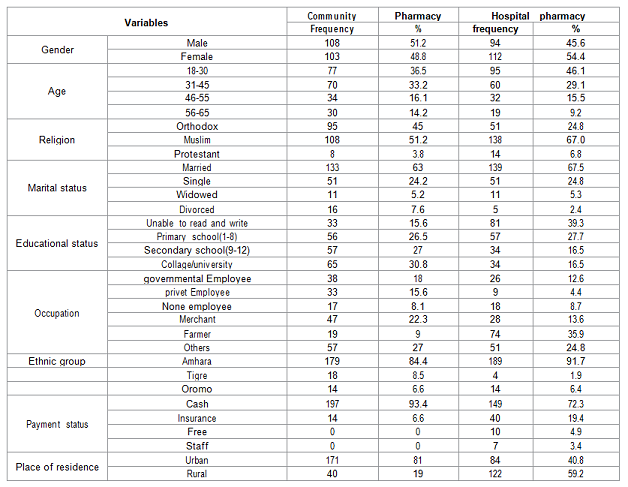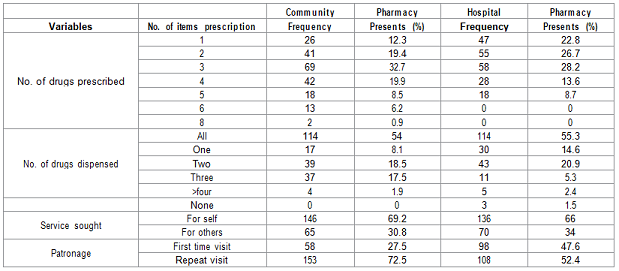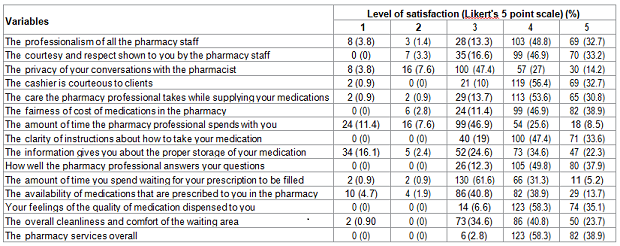Research Article :
Client satisfaction is a multidimensional
construct that reflects the quality of service provided by healthcare
providers. The objective of this study was to develop a client satisfaction
scale that could be used to assess the quality of pharmacy services provided in
Boru media hospital community and hospital pharmacy in respect of client
perception of specific aspects of service performance. Institutional based
quantitative cross sectional study was conducted with clients exit interview at
hospital outpatient pharmacy and community pharmacy during the period from
February 30, 2017 to March 30, 2017. The study was carried out in 417
participants who were selected by systematic random sampling technique. The
data was collected on predesigned and pretested questionnaire. Regarding availability of
pharmaceutical items at community pharmacy114 (54%) had gotten a chance of all
prescribed items. About patronage of participants 153(72.5%) were repeat visit
in community pharmacy. with regards the courtesy and respect shown by the
pharmacy staff 96.7%, 95.6% participants were found satisfied in community and
hospital pharmacy respectively. Near about 39(18.5%) participants in community
pharmacy and 70(34%) participants in hospital pharmacy replied that they were
unsatisfied with information gives about the proper storage of their
medication. This study showed that the overall
satisfaction level of clients of both hospital and community pharmacy was high.
About fairness of cost of medications in the community pharmacy only 6(2.8%)
were found very dissatisfactory, whereas 3(1.5%) Participants at hospital
pharmacy were very dissatisfactory. Evaluating of client
satisfaction is along-established and vital aspect of measuring the quality
and sustainability of a service [1,2]. Client
satisfaction, as a performance measure is considered as the personal evaluation
or appraisal of health care services and providers. Although an increasing
focus of client satisfaction in pharmacy
is being shifted from dispensing functions, error rates, and costs to the
quality of pharmacy performance, including patient care services, available
literature on pharmacist performance of patient
care services in comprehensive medication management is limited [2]. Without appropriate client satisfaction measures demonstrating value,
pharmacists can be at a shortcoming when requesting reimbursement for these pharmacy
services [3]. It serves as a bond between
patients desires and services that are provided and allows an assessment that
directly reflects the patients perspective on a service [4]. Boru meda Hospital (BMH) has therefore already a competitive
advantage. But the hospital should not only gain its important position through
this channel but also through becoming more customer oriented, as patients
should become more willingly to enter the hospital. This research will focus on
differences between satisfaction in pharmacy service of patients and
improvements to obtain better quality
care through service quality strategies. Study design and period Institutional based quantitative cross sectional study were conducted with patient exit interview and
study participants were selected by systematic random sampling technique. The
study was conducted from February 30, 2017 to March 30, 2017. Study area The study
was conducted at BMH pharmacy and community pharmacy, which are found in south Wollo Zone of Amhara
regional state and are located 4010 km,
and 400 km away from Addis Ababa the capital city of Ethiopia respectively.
Source population The source population for this study
was all clients to visit pharmacy at BMH OPD pharmacy and community pharmacy. Study population All clients whose age ranges are
from18 years to 65 years old to visit pharmacy at BMH OPD pharmacy and community
pharmacy during data collection period. Systematic random sampling technique
was used to select the study participants.Based on the last three monthclients flow
trend15,235 clients in
community pharmacy and 15,540 clients
in hospital outpatient pharmacy attendants recorded.
So we can estimate the monthly average number of hospital OPD pharmacy and
community pharmacy clients are 5,180
and 5,078 respectively. The number of actual study participants
from both pharmacies are calculated and taken disproportionally. ·
Client satisfaction Availability of pharmaceutical items, Service sought and patronage Satisfaction level of
measurements Patient waiting time: The interval
between departure from the proceeding pharmacy station and receiving pharmacy
service Satisfaction: Attaining ones need or
desire. Very satisfactory: Above ones
expectation. Satisfactory: Just ones expectation. Dissatisfactory: Below ones
expectation. Very dissatisfactory: Fail to meet
ones expectation usually leading to disappointment Service: any activity undertaken in
the pharmacy to meet the rational use of medication Data Collection Method and tool Structured interview questionnaires
were adapted and modified from different related literatures to collect data on
the socio-demographic variables and associated factors [5-9].
It was prepared in English and then translated to Amharic language and then retranslated
to English to check for its consistency. The data was collected through face to
face interview by trained collectors. To assure data quality, the
instrument was retranslated to local language (Amharic). The recruited data collectors
were trained for two days on the objective, confidentiality of information,
relevance of the study and respondents right, pretest, informed consent and
techniques of interview. Before going in to data collection, the structured
questionnaire was pre-tested on 5% of the total sample on other than selected
health centers for consistence of understanding the survey tool and
modifications was done accordingly. Close supervision was undertaken during
data collection. This study was approved by chief
executive officer, and the head of the pharmacy
department in the BMH. Respondents were assured that their responses would
be kept confidential. After collection of the data, the
responses were coded and entered in to SPSS version 20 for analysis. Then, the
frequency distribution of dependent and independent variables were worked out. Out of 211 participants in community
pharmacy 108 (51.2%) male, 103 (48.8%) female, a
maximum of 77 (36.5%) were between 18 and 30 years, followed by 70 (33.2%)
between 31and 45 years. majority of 171 (81%) of participants Place of
residence were urban and the rest 40 (19%) of participants were rural. The
participants were asked about payment status 197 (93.4%) were cash, whereas 40
(19%) were insurance (Table1). The study also included 206 clients
attending at OPD hospital pharmacy. There were
94 (45.6%) male, 112 (54.4%) females, the majority 95 (46.1%) of the
participants were belongs to 18-30years age group followed by 60 (29.1%) from
31-45 age group (Table1). As shown in Table 2 regarding
availability of pharmaceutical items at community pharmacy, 114 (54%)
participants were found all prescribed items. The maximum number of prescribed
items was 8 and prescriptions contain 3 items accounts the maximum number 69
(32.7%). About patronage of participants 153 (72.5%) were repeat visit (Table 2). About availability of pharmaceutical
items at hospital pharmacy, 114 (55.3%) participants only had gotten a chance
of all prescribed items. The maximum number of prescribed items was 5 and
prescriptions contain 3 items accounts the maximum number 69 (32.7%). Regarding
the counseling time of community
pharmacy 40 (19 %) participants were found unsatisfied, whereas14 (6.8%)
participants in the hospital pharmacy were found unsatisfied. About the
pharmacy professional well answers clients questions all participants were
satisfied in community pharmacy personals, while 19 (9.2) participants in
hospital pharmacy were found unsatisfied. Near about 39 (18.5%) participants in
community pharmacy and 70 (34%) participants in hospital pharmacy replied that
they were unsatisfied with information gives about the proper storage of their
medication. Regarding the cashers was courteous
to clients 99.1% and 83% participants were satisfied in community and hospital
pharmacy respectively. Participants who were very dissatisfactory,
dissatisfactory with statement were considered as unsatisfied and the rests
were considered as satisfied. About the courtesy and respect shown
by the pharmacy staff 96.7%, 95.6% participants were found satisfied in
community and hospital pharmacy respectively. When asked about fairness of cost
of medications in the community pharmacy only 6 (2.8%) were found very
dissatisfactory, whereas 3 (1.5%) Participants were very dissatisfactory at
hospital pharmacy. Maximum numbers of community pharmacy Participants 123
(58.3%) were satisfactory with regarding the community pharmacy services
overall and also 149 (72.3%) in hospital pharmacy. Only 2 (0.9%), 3 (1.5)
participants were unsatisfied with the overall cleanliness and comfort of the
waiting area in community and hospital pharmacy respectively (Table 3 and 4). Table 3:
Satisfaction level of
measurements of clients attending in BMH community pharmacy. Table 4:
Satisfaction level of
measurements of clients attending in BMH OPD pharmacy. Pharmaceutical
services that are provided in health care institutions need to be satisfactory
so as to provide the intended effects of the services. This study has clearly
demonstrated that the proportion of participants who were at least satisfied is
higher at Borumeda hospital pharmacy and community pharmacy. Most of
the variables were also found to be determinants of patient satisfaction in
studies carried out elsewhere [10-15]. Patient
satisfaction is an important measure of how well services are provided. The
majority of participants in this study were very or moderately satisfactory
with a number of pharmacist characteristics. Similar findings were obtained in the
USA, the UK and the Netherlands. The
majority of participants in this study frequently or always visited the same
community pharmacy; indicating a high pharmacy patronage (72.5%), while
participants in the hospital pharmacy the repeat and new visits ratio were
closest one, which accounts 52.4%, 47.6% respectively. This study had done in
BMH pharmacy and community pharmacy, the authors are not familiar with any
study published discussed this issues.
The maximum satisfactions level of community pharmacy, 48.8%
participants were
satisfactory with regards the professionalism of all the pharmacy staff. While satisfactions
of participants in the hospital pharmacy
with professionalism of all the pharmacy staff, 44.2%
participants were moderately satisfactory whereas 31.6% participants were
satisfactory. A similar study was conducted in Saudi Arabia, 56% participants were
moderately satisfactory and followed by 20.8%
participants were satisfactory. With regard to the courtesy and
respect shown by the pharmacy staff only 4.4% hospital pharmacy, 3.3% community
pharmacy participants were unsatisfied.
Similar study was conducted at Gondar university referral hospital opd pharmacy
with the findings of Surur et al, only 24.5% patients unsatisfied. In this study all the participants in
community pharmacy were satisfied with the clarity of instructions about how to
take their medication and how well the pharmacy professional answers their
questions, while 90.8, 86.5% participants in hospital pharmacy were only
satisfied respectively. A cross-sectional study conducted in Malta shows that
the majority of the consumers were highly or moderately satisfied with various
pharmacist characteristics, such as, provision of instructions on how to take
medications (94%), pharmacist knowledge and ability to answer questions (81%). Pharmacists in the hospital pharmacy
(93.2%) were better satisfied than the community pharmacy (81%) With amount of
time the pharmacy professional spends with clients (counseling time). in other study on community pharmacy in Malata
shows that amount of time the pharmacist spends with them , were 73%
participants satisfied. In this study also asses the cashers
characteristics, the community pharmacy cashers, were highly satisfied (99.1%)
their clients than the hospital pharmacy cashers (83%). The
regular provision of adequate amounts of appropriate health commodities is
crucial if health services are to be effective and credible.A third of the worlds population,
including almost half of the population on the African continent, lacks
systematic access to essential drugs. The availability of essential medicines
is a persistent challenge in developing countries. The availability of
essential medicines is a persistent challenge in developing countries. The
health consequences from such low levels of availability is pronounced. In this
study were showed that Participants found their medications fully, in community
pharmacy (54%) and in hospital pharmacy (55.3%). As shown in table 1 Place of
residence of participants in community pharmacy, majority were urban (81%)
while in hospital pharmacy, were rural (59.2%) higher than urban (40.8%)
participants. Majority of participants both in community and hospital pharmacy,
were accounts in 18-30 years 36.5%, 46.1% respectively. This study showed that the overall
satisfaction level of clients of both hospital and community pharmacy was high.
About fairness of cost of medications in the community pharmacy only 6 (2.8%)
were found very dissatisfactory, whereas 3 (1.5%) Participants were very
dissatisfactory at hospital pharmacy. Based on the major findings of the study, the
following recommendations are suggested. The
hospital should be given more attention to assure availability of pharmaceuticals
in both hospital and community pharmacy. The
pharmacists should be given more attention to: The clarity of instructions about how to take
medication to clients, the amount of time the pharmacy professional spends with
clients andthe information gives about the proper storage of medication
to client. 1. Williams B. Patient
satisfaction: A valid concept Social Science and Medicine (1994) 38: 509-516. 2. Naik Panvelkar P,
Saini B, Armour C. Measurement of patient satisfaction with community pharmacy
services: A review (2009) Pharmacy World Science
31: 525 -537. 3. Schommer JC,
Kucukaslan SN. Measuring patient satisfaction with pharmaceutical services
(1997) American Journal of Health-System Pharmacy 54:
2721-2732. 4. Larson, LN, Rovers
JP, Mackeigan LD. Patient satisfaction with pharmaceutical care: Update of a
validated instrument (2002) Journal of American
Pharmacy Association 42: 44-50. 5. Francesca W,
Francesca T, Lilian M Azzopardi, Marise G, Maurice Zarb-Adami, et al. Consumer
perception of the community pharmacist and
community pharmacy services in Malta (2010) Journal of Pharmaceutical Health
Services Research. 6. Pronk MCM, A. Th. G.
Blom, R. Jonkers, A. Bakker. Evaluation of patient opinions in a pharmacy level
intervention study (2003) International Journal
of Pharmacy Practice 11: 143-151. 7. Kukukarslan S,
Schommer JC. Patients’ expectations and their satisfaction with pharmacy
services (2002) Journal of America Pharmacy Association
42: 489-496. 8. Ala’Eddin Mohammad
Khalaf A, Mohammad Ali Saleh A, Saleh Ali Saleh A, Omar Zayyan A, Hussein
Mohammad Al-B. Factors Influencing Patient
Satisfaction with Pharmacy Services: An Empirical Investigation at King Fahd
Armed Forces Hospital, Saudi Arabia (2016)
International J of Business and Management. 9. Ghufran Mohamed
Elhafiz A, Alyaa Faisal A. Abdalla Omer E. An investigation of patient
satisfaction with pharmaceutical care services (2015) World
Journal of Pharmacy and Pharmaceutical Sciences 4: 180-191. 10. Abdrrahman Shemsu
S, Fitsum Sebsibe T, Genet G, Elsabet M, Meseret T et al. Satisfaction of
clients with the services of an outpatient pharmacy
at a university hospital in northwestern Ethiopia: A cross-sectional study
(2015) BMC Health Services Research 15: 229. 11. Larson LN, Rovers
JP, MacKeigan LD. Patient satisfaction with pharmaceutical care; update of a
validated instrument (2002) Journal of American
Pharmacy Association 42: 44–50. 12. Ried LD. Patients’
satisfaction and their perception of the pharmacist (1999) Journal of America Pharmacy
Association 39: 835-842. 13. Bell HM. Societal
perspectives on the role of the community pharmacist and community-based
pharmaceutical services (2000) Journal of social and
administrative pharmacy 17: 119-128. 14. Pronk MCM.
Evaluation of patient opinions in a pharmacy: Level intervention study (2003)
International Journal of Pharmacy Practice 11: 143-151. 15. Farah K. Alhomoud,
Amr K, Ahmed A, Faten A. Quality Assessment of community pharmacy services
provided in the United Arab Emirates: Patient experience and satisfaction
(2016) Journal of Applied Pharmaceutical Science ; 6: 017-023. Abebaw
Tegegn Damtie, Department of pharmacy, Dessie Health Science College, Ethiopia,
Tel: (251)0910299395; Fax: 0333124965 E-mail: mabebaw12@gmail.com Damtie AT,
Getahun AM (2017) A Cross-Sectional Study of Client Satisfaction towards
Services Received at Boru Meda Hospital
Pharmacy on Opd Basis and Community Pharmacy. NHC 120: 26-31 Satisfaction, Pharmacy, Clients; Community
pharmacy, Boru meda hospitalA Cross-Sectional Study of Client Satisfaction towards Services Received at Boru Meda Hospital Pharmacy on Opd Basis and Community Pharmacy
Abebaw Tegegn Damtie and Assen Muhe Getahun
Abstract
Background: Full-Text
Introduction
Methods
Inclusion criteria
Exclusion criteria
Sampling procedure
Variables
of the Study
Dependent
variable
Independent
variable
Socio- demographic
characteristics
Operational Definition
Data
quality control
Ethics
Data Processing and Analysis
Result




Discussion
Conclusions
Recommendation
To BMH
To pharmacists
References
*Corresponding author
Citation
Keywords